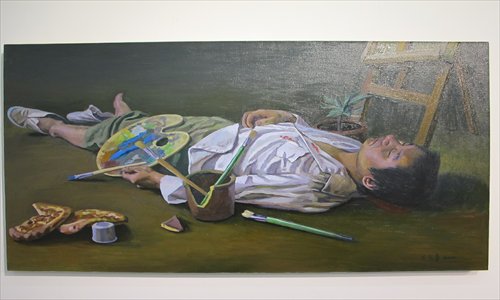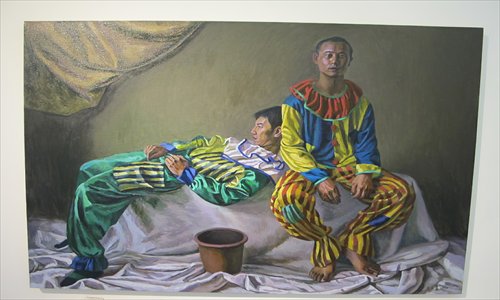Artists Arise


Chinese contemporary art has developed for decades and young artists born in the 1970s and 1980s have gradually entered into the public's consciousness: some have even begun to accumulate fame. But when talking about contemporary artists in China, the first people we think of are still artists like Fang Lijun, Wang Guangyi and Yue Minjun who rose to fame in the 1990s.
Chen Haitao, director of Platform China, one art institution engaged in discovering new talents, said the total number of works by young artists is increasing.
"Young artists perform generally well in the primary market. But exploring and discovering talents are full of uncertainty and risks," he said, "and the shift of focus takes time."
Signs of rising
Several days ago, works that have won prizes in the third Newstar Art Festival, a national platform for young artists, were exhibited in Nanjing. The exhibit covers over 100 young contemporary artists' works. In August, the China Central Academy of Fine Arts' Art Museum (CAFAM) held a large "future exhibition" to demonstrate 93 young artists' works.
The attention on young artists has been growing, indicating the domestic eagerness to rally the potential art market. Besides exhibitions, young artists appear more frequently in auctions and galleries. Art institutions like Platform China and Gallery Yang are dedicated to promoting young artists.
Amid the growing attention is the rising number of their works in galleries and art expos. Chen told Global Times that the number of buyers and collectors for young artists is growing due to the relatively low prices. In 2012 Art Beijing's "Art Nova 100" section for young artists, 63.5 percent of the exhibited works were under 50,000 yuan ($7,951), accounting for 76.8 percent of all the works sold.
In the auction market, the price is also rising. Sotheby's spring auction this April made an effort to promote artists born after 1970. Jia Aili, an artist born in 1979, became the most noticeable with his oil painting It's Not Only You Who is Pale (triptych) reached as high as HKD 6.62 million ($850,000), breaking his personal record. It is higher than the price of several Zhang Xiaogang paintings, though Zhang's Bloodline-Big Family: Family No.2 reached HKD 52.18 million - the highest in the section for Chinese contemporary art.
Li Qing, another young artist born in 1981, reached the hammer price of 322,000 yuan with his Spot the Differences in this year's spring auction market. Since 2006 when his works started to enter the market, over 20 pieces were sold above 100,000 yuan - relatively high for a young artist.
To Chen, the emergence of young artists is inevitable. "The art market is dynamic, and needs new artists to add fresh blood, and new collectors' demand on relatively low-priced works helps get the process going," he said.
As to the controversially high prices for young artists' works, he said it is fine as long as the price matches their artistic growth.
Different touch
An exhibition held in Shenzhen earlier this month shows that young artists are concerned with the details of daily life, as opposed to their seniors who pay more attention to history, ideology, collectivism and other big topics.
"The difference is obvious," Chen told Global Times. "They are from different time periods and are branded [accordingly]. Today's works are more diversified and international." He said that older artists are more conscious about ideology and politics and with strong "revolutionary" color. Young artists focus more on the art itself, social development and cultural ecology.
Platform China is holding an exhibition for Qi Wenzhang, an artist born in 1981. In the exhibition named Self Portrait, several pictures reflect the art market and living conditions of a group of artists, who are painting, starving, and being killed by painting and becoming clowns.
Meanwhile, the young artists are not unconcerned with politics or about social problems as some art critics think. As shown in the CAFAM's exhibition, the artists born after 1978 do not avoid social problems and public life in their works. For example, Song Tuo painted hundreds of portraits of civil servants who are fresh and alive and meanwhile parts of the system.
To some, while many famous artists become cynical under the political and financial pressure, young artists are more conscious of present society and concerned about the situation both the world and they themselves are in.
But to curator Zhu Qi, young artists lack innovation in their methods of expression, including those that are regarded as extraordinary. "Most of them are still in the stage of imitating and borrowing international artistic concepts," he told Global Times.
He sees few new things in young artists' works. "It is normal. It takes years and even decades to produce several excellent artists," he said, "besides, the society has entered a smooth period, unlike in the 1980s when there were huge social transitions."
"It is a time when the elder artists decline in creation and the young ones cannot pick up yet," Zhu said, "they need to mature and make breakthroughs in depth and have new discoveries about society as well as improving their theoretical knowledge."
Invest in future
To Chen, while young artists begin to emerge in the market, elder influencing artists, such as Fang Lijun and Wang Guangyi are still reigning.
Platform China mainly explores innovative and experimental works. "It is hard to spot talent," Chen said, "You must have complete and systematic understanding of both artists and their works." He cited the example of Qi Wenzhang who did not receive education above middle school but shows great potential. "He is special and valuable in that he has been persistent in his painting style without being turned or bounded by so-called popular trends."
He added the job is one of risks and they have to be cautious while paying close attention to young artists. "The process of exploration is full of both possibilities and uncertainty," he said. Even among artists who are regarded as new stars, there are fluctuations.
The same sense of caution is reflected in the auction market. Even though young artists were frequently promoted in 2012, the market responded cautiously with the number of young artists' works declining in several major auctions such as Sotheby's and China Guardian.
Zhu Qi said that young artists need time to amass and there is no rising group at present. The attention being paid now is mainly a market phenomenon. "Some comments on young artists are exaggerated to create a wave. Too much market push is not good," he said, "innovation is getting harder, so it takes longer for excellent artists to emerge." But he is optimistic that outstanding works will appear, as the society is still undergoing change.